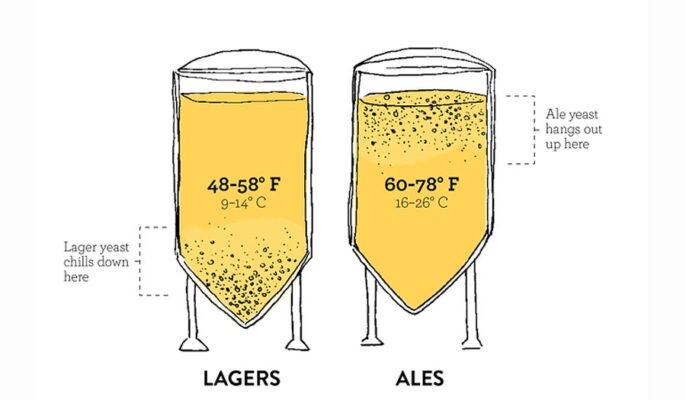The fermentation process is an important step in brewing. Before you actually start making a new beer, it’s best to decide which beer you want to make by choosing a fermentation method. Top and bottom fermentations result in very different end products. So before that you know the difference between top fermenting and bottom fermenting and information about them.
Beer and Fermentation
When it comes to brewing beer, the ingredients and process are simple. A grain (usually barley or wheat) is germinated, a process that changes the microscopic structure of proteins, starch granules and cell walls. The sprouted grains are then broken up so that the sugars in them are most accessible.
The cracked grains are then boiled and soaked in filtered water to release all those sugars into the water. This sugary grain water is called “wort”. Yeast is added to the wort, and this is where the real brewing begins.
What is Top Fermentation?
Top fermenting refers to beer fermented by yeast that accumulates and floats on the liquid at the top of the tank. Top fermentation tends to be the faster fermentation method, but it still takes at least a week or more to ferment. Top-fermenting yeast needs to be kept at a higher temperature than bottom-fermenting yeast, around 60 to 75°F. IPAs and stouts are other common beer types produced by top fermentation.
What is Bottom Fermentation?
Bottom fermentation is when the yeast in the tank settles to the bottom. Yeast granules drift down, starting at the top and finally clumping together at the bottom. One major way in which top and bottom fermentation differ is how long bottom fermentation takes. Bottom-fermented beers take longer to ferment, often taking more than a month to complete. Bottom fermentation occurs at lower temperatures, between 42 to 54°F. Lager is the most common type of beer that uses bottom fermentation.
What is the difference between top fermentation and bottom beer fermentation?
Fermentation temperature is different
Top ferments ferment at high temperatures of 60 to 75°F, while bottom beers ferment at cooler temperatures of 42 to 54°F.
Yeast behavior
Ale yeast, the yeast used to top ferment beers, tends to rise to the top of the fermentation vessel, while lager yeast settles to the bottom of the fermentation vessel.
Different flavor
Top fermented beers have a wider range of flavors and aromas. They contain fruity esters and pungent phenolics. Light and fresh, but also full-bodied and complex, with hints of caramel, nuts and spices.
Bottom-fermented beers tend to be milder in flavor and often cleaner and crisper.

Different beer styles
Top fermented: Examples include pale ales, IPAs, stouts, porters, wheat beers, and Belgian-style beers.
Bottom fermentation: e.g. Pilsner, München Helles, Dortmund, Bock.
Different foam
Top-fermented beers have a finer head, while bottom-fermented beers have a crisper, more persistent head.
Different yeast strains
The top fermentation uses an ale yeast strain and the bottom fermentation uses a lager yeast strain.
Which fermentation method is suitable?
While top fermentation is the most common brewing method, it may not give you the results you want. The temperature requirements of the fermentation process and how to maintain it need to be kept in mind. Micet Group supplies high-quality jacketed fermenters for this purpose. Jacketed fermenters make it easier to adjust and maintain the desired temperature during fermentation.




